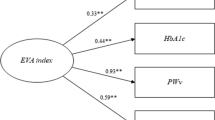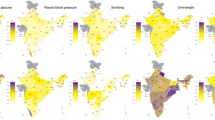Abstract
The objectives were to analyse whether cardiovascular risk factors appear simultaneously in the population and to determine whether it depends on age. The participants belong to a random sample of individuals 25–74 years of age, representative of the non-diabetic population free of coronary heart disease of the province of Gerona, Spain, studied during 1994–1996. Exploratory factor analysis was used to assess clustering of cardiovascular risk factors and confirmatory factor analysis to compare clustering among age groups (25–54 and 55–74). Results: In the 25–54 age group, we observed in both sexes the Central Metabolic Syndrome factor, which included glucose, lipids, and waist-to-hip ratio, and Metabolic Hypertension factor, which included systolic and diastolic blood pressures, waist-to-hip ratio, low-density lipoproteins, glycaemia, and triglycerides. In the 55–74 age group we observed in both sexes the Central Metabolic Syndrome factor, with the same composition as in younger subjects, and Isolated Hypertension factor, composed only of systolic and diastolic blood pressures. In both sexes, the χ2 value for the model of the combined age groups was higher than the sum of χ2 values of the best models for each age group separately (p < 0.01), which indicates that both sexes presented factor structures that differed by age group. Conclusions: The Central Metabolic Syndrome factor was common to all four sex and age groups studied. In younger subjects blood pressure was related to lipids, obesity, and glycaemia, suggesting the existence of a Metabolic Hypertension factor, while systolic and diastolic blood pressures were found to be the only significant variables in the hypertension factor after 54 years.
Similar content being viewed by others
References
Kuulasmaa K, Tunstall-Pedoe H, Dobson A, et al. Estimation of contribution of changes in classic risk factors to trends in coronary-event rates across the WHO MONICA Project populations. Lancet 2000; 355: 675-687.
Fuster V, Gotto A, Libby P, et al. Task Force 1. Pathogenesis of coronary disease: The biologic role of risk factors. JACC 1996; 27: 964-1047.
The WHO MONICA Project. A worldwide monitoring system for cardiovascular diseases: Cardiovascular mortality and risk factors in selected communities. World Health Stat Annu 1989; 27-149.
Liese AD, Mayer-Davis EJ, Haffner SM. Development of the multiple metabolic syndrome: An epidemiologic perspective. Epidemiologic Reviews 1998; 20: 157-172.
Schmidt MI, Watson RL, Duncan BB, et al. Clustering of dyslipidemia, hyperuricemia, diabetes and hypertension and its association with fasting insulin and central and overall obesity in a general population. Metabolism 1996; 45: 699-706.
Criqui MH, Barrett-Connor E, Holdbrook MJ, et al. Clustering of cardiovascular disease risk factors. Prev Med 1980; 9: 525-533.
Eriksson H, Welin L, Wilhelmsen L, et al. Metabolic disturbances in hypertension: Results from the population study 'men born in 1913'. J Intern Med 1992; 232: 389-395.
Edwards KL, Austin MA, Newman B, et al. Multivariate analysis of the insulin resistance syndrome in women. Arterioscler Thromb 1994; 14: 1940-1945.
Meigs JB, D'Agostino RB, Wilson PW, et al. Risk variable clustering in the insulin resistance syndrome. The Framingham Offspring Study. Diabetes 1997; 46: 1594-1600.
Chen W, Srinivasan SR, Elkasabany A, et al. Cardiovascular risk factors clustering features of insulin resistance syndrome (Syndrome X) in biracial (Black-White) population of children, adolescents, and young adults: The Bogalusa Heart Study. Am J Epidemiol 1999; 150: 667-674.
Edwards KL, Burchfiel CM, Sharp DS, et al. Factors of the insulin resistance syndrome in nondiabetic elderly Japanese-American men. Am J Epidemiol 1998; 147: 441-447.
Alberti KG, Zimmet PZ. Definition, diagnosis and classification of diabetes mellitus and its complications: Part 1: diagnosis and classification of diabetes mellitus provisional report of a WHO consultation. Diabet Med 1998; 15: 539-553.
Third Report of the National Cholesterol Education Program (NCEP). Expert Panel on Detection, Evaluation, and Treatment of High Blood Cholesterol in Adults (Adult Treatment panel III) final report. Circulation 2002; 106: 3143-3421.
Ford ES, Giles WH. A comparison of the prevalence of metabolic syndrome using two proposed definitions. Diabetes Care 2003; 26: 575-581.
Myers L, Coughlin SS, Webber LS, et al. Prediction of adult cardiovascular multifactorial risk status from childhood risk factor levels. The Bogalusa Heart Study, Am J Epidemiol 1995; 142: 918-924.
Masiá R, Pena A, Marrugat J, Sala J, et al. and the REGICOR Investigators. High prevalence of cardiovascular risk factors in Gerona, Spain, a province with low myocardial infarction incidence. J Epidemiol Commun Health 1998; 52: 707-715.
World Health Organisation. MONICA manual. Geneva: World Health Organisation, 1992.
Kleinbaum DG, Kupper LL, Muller KE. Applied regression analysis and other multivariate methods. Boston, MA: Kent Publishing Company, 1988.
Bollen KA. Structural equations with latent variables. New York: John Wiley & Sons, 1989.
Pyorala M, Miettinen H, Halonen P, et al. Insulin resistance syndrome predicts the risk of coronary heart disease and stroke in healthy middle-aged men: The 22-year follow-up results of the Helsinki Policemen Study. Arterioscler Thromb Vasc Biol 2000; 20: 538-544.
Lempiainen P, Mykkanen L, Pyorala K, et al. Insulin resistance syndrome predicts coronary heart disease events in elderly nondiabetic men. Circulation 1999; 100: 123-128.
DeFronzo RA, Ferrannini E. Insulin resistance: A multifaceted syndrome responsible for NIDDM, obesity, hypertension, dyslipidemia and atherosclerotic cardiovascular disease. Diabetes Care 1991; 14: 173-194.
Reaven GM, Lithell H, Landsberg L. Mechanisms of disease: Hypertension and associated metabolic abnormalities. The role of insulin resistance and the sympathoadrenal system. N Engl J Med 1996; 334: 374-381.
Reaven GM, Chen YDI. Role of insulin in regulation of lipoprotein metabolism in diabetes. Diabetes Metab Rev 1988; 4: 639-652.
Cassano PA, Segal MR, Vokonas PS, et al. Body fat distribution, blood pressure, and hypertension: A prospective cohort study of men in the Normative Aging Study. Ann Epidemiol 1990; 1: 33-48.
Gray RS, Fabsitz RR, Cowan LD, et al. Risk factor clustering in the insulin resistance syndrome. The Strong Heart Study. Am J Epidemiol 1998; 148: 869-878.
Sakkinen PA, Wahl P, Cushman M, et al. Clustering of procoagulation, in.ammation and fibrinolysis variables with metabolic factors in insulin resistance syndrome. Am J Epidemiol 2000; 152: 897-907.
Edwars KL, Newman B, Mayer E, et al. Heritability of factors of the insulin resistance syndrome in women twins. Genet Epidemiol 1997; 14: 241-253.
Author information
Authors and Affiliations
Rights and permissions
About this article
Cite this article
Ramos, R., Marrugat, J., Basagaña, X. et al. The Role of Age in Cardiovascular Risk Factor Clustering in Non-Diabetic Population Free of Coronary Heart Disease. Eur J Epidemiol 19, 299–304 (2004). https://doi.org/10.1023/B:EJEP.0000024697.55346.c2
Issue Date:
DOI: https://doi.org/10.1023/B:EJEP.0000024697.55346.c2




